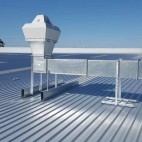The energy situation is set to change when the two new coal fired power stations (Medupi and Kusile) come online during 2014 and onwards. South African energy industry players (generally) have very detailed, but fragmented industry-specific energy knowledge.
The wind industry focuses on wind, the solar on solar and so forth. This kind of silo’d information is not optimal from an overall perspective, since developments take place that are in the interests of certain players, but not South Africa as a consolidated whole, writes Energy and Power Systems Team Leader Johan Muller at growth partnership company, Frost & Sullivan.
The question therefore is posed: Where are we headed to from a holistic energy landscape point of view?
Power supply
The South African power supply is dominated by Eskom, who supplies more than 94% of the power to South African industries, and 40 to 45% of power required in Africa.
The power supplied by Eskom’s 13 coal fired powerplants (generating 37 715MW per annum) is generally in the Mpumalanga region. Taking into account other forms of power generation (gas, nuclear, hydro and the like), Eskom’s total generation is 44 084MW per annum.
The new builds, which are due to come on-line from 2014 onwards, include the two new coal-fired power stations (Kusile and Medupi – 4 800MW each), pumped storage schemes (Ingula – 1 332MW) and a 100MW wind energy facility (Sere Windfarm).
Power demand
The South African power demand landscape is a complex system with multiple layers and variables. It is important to note that power demand should be distinguished from power consumption.
Power consumption can be explained as the total amount of energy used by a sector, industry or market player. Power demand refers to the amount of energy demanded by a sector, industry or market player for consumption at a specific point or rate.
One of the tools to visually represent the load profile (and power demand) situation is a graphic called a load profile/curve.
Typically, for measurements relating to a day, it takes the shape of an ‘M’ with a morning peak and evening peak, resulting from the residential sector when the power demand (from using water heating appliances and cooking appliances) is increased. It is these spikes in energy usage which results in black-outs when the power supplied does not meet power demanded.
Despite the general populace’s negative opinion of Eskom, the fact that the ‘lights have stayed on’ this winter (2012) is testament to massive drives from Eskom on both the supply and demand side to ensure energy security.
Various initiatives in the demand side management division of Eskom (such as solar water heater roll-outs, CFL light bulb roll-outs, power alert initiatives and many more) have led to a reduced power demand which, in turn, have led to an increased reserve margin to ‘keep the lights on’.
The current situation is, however, not sustainable, since typically with rising economic growth and rising population figures comes increased energy demand. This demand gap needs to be addressed even with the recent spate of energy efficiency technologies which are flooding different market sectors.
Role of IPPs in the future
The role of IPPs in South Africa is still in the developmental phase. The primary aim is to make a financial return by selling electricity back into the South African electricity grid (currently controlled by Eskom).
Secondary, is the increase in energy security. With reserve margins in 2012 supposed to be at the global standard of 15%, but often dipping down as low at 1%, the alarm bells are ringing.
The role of IPPs in the future is dependent on various factors, such as: financial return on projects, policy clarity by the South African government, the availability of natural resources (especially coal and water), the future growth rate of the South African economy, and the participation of relevant market players (such as the assistance of Eskom with issues such as grid integration).
During a recent project conducted by Frost & Sullivan, a leading solar PV market player predicted solar PV to reach grid parity in 2017/2018 in current South African conditions. Once this point is reached, industry will be faced with commercially viable alternatives to being connected to the national grid.
Role of energy intensive users
The energy intensive users of South Africa are an association of energy consumers who (combined) consume between 40-50% of all the energy in South Africa. They include companies such as Sasol, PPC, ArcelorMittal, Xstrata SA, BHP Billiton and various others. Although these companies are driven by bottom-line initiatives, they to a large extent also adhere to sustainability concerns. This means that they often invest in renewable energies/energy efficient initiatives with the triple purpose of gaining independence from the national power utility, increasing energy security, as well as adhering to climate change initiatives, such as the avoidance of carbon taxes.
These consumers are tier one businesses, in the sense that they are market leaders in their industries. They are often listed on a stock exchange and are in the public eye.
They are – in many instances – public about their energy usage and carbon emissions as is evident by participation in the carbon disclosure project.
In the carbon disclosure project, the top 100 largest South African companies, by market capitalisation based on the FTSE JSE All Share index, are asked to publish certain key metrics and strategies linked to energy usage, based on measurement and verification standards.
The above invariably results in the energy intensive users finding a balancing point between keeping the best interests of shareholders at heart, as well as adhering to social responsibilities.
It is safe to assume that the energy intensive users are striving towards energy efficiency; although it might not always be in the same timeframes as targets set by the South African government.










